
Albrecht III was Elector of Brandenburg from 1471 until his death, the third from the House of Hohenzollern. A member of the Order of the Swan, he received the cognomen Achilles because of his knightly qualities and virtues. He also ruled in the Franconian principalities of Ansbach from 1440 and Kulmbach from 1464.

Frederick was the last Burgrave of Nuremberg from 1397 to 1427, Margrave of Brandenburg-Ansbach from 1398, Margrave of Brandenburg-Kulmbach from 1420, and Elector of Brandenburg from 1415 until his death. He became the first member of the House of Hohenzollern to rule the Margraviate of Brandenburg.

Ingolstadt is an independent city on the Danube, in Upper Bavaria, with 142,308 inhabitants. Around half a million people live in the metropolitan area. Ingolstadt is the second largest city in Upper Bavaria after Munich and the fifth largest city in Bavaria after Munich, Nuremberg, Augsburg and Regensburg. The city passed the mark of 100,000 inhabitants in 1989 and has since been one of the major cities in Germany. After Regensburg, Ingolstadt is the second largest German city on the Danube.

The University of Ingolstadt was founded in 1472 by Louis the Rich, the Duke of Bavaria at the time, and its first Chancellor was the Bishop of Eichstätt. It consisted of four faculties: theology, law, artes liberales and medicine, all of which were contained in the Hoheschule. The university was modeled after the University of Vienna. Its chief goal was the propagation of the Christian faith. The university closed in May 1800, by order of the Prince-elector Maximilian IV.

Nuremberg Castle is a group of medieval fortified buildings on a sandstone ridge dominating the historical center of Nuremberg in Bavaria, Germany.

The Imperial County of Ortenburg was a state of the Holy Roman Empire in present-day Lower Bavaria, Germany. It was located on the lands around Ortenburg Castle, about 10 km (6 mi) west of Passau. Though the Counts of Ortenburg—formerly Ortenberg—emerged in the 12th century as a cadet branch of the Rhenish House of Sponheim (Spanheim) who then ruled over the Duchy of Carinthia, an affiliation with the Carinthian Ortenburger comital family is unverifiable.
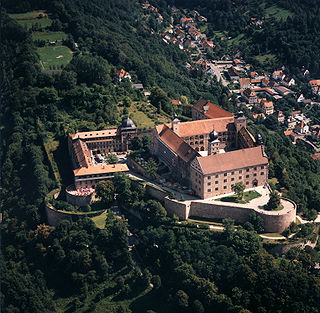
Plassenburg is a castle in the city of Kulmbach in Bavaria. It is one of the most impressive castles in Germany and a symbol of the city. It was first mentioned in 1135. The Plassenberg family were ministerial of the counts of Andechs and used as their seat the Plassenburg. The House of Guttenberg, a prominent Franconian noble family, traces its origins back to 1149 with a Gundeloh v. Blassenberg (Plassenberg). The name Guttenberg is derived from Guttenberg and was adopted by a Heinrich von Blassenberg around 1310. From 1340, the Hohenzollerns governed from Plassenburg castle their territories in Franconia till 1604. The Plassenburg was fortress and residence for the Hohenzollerns.
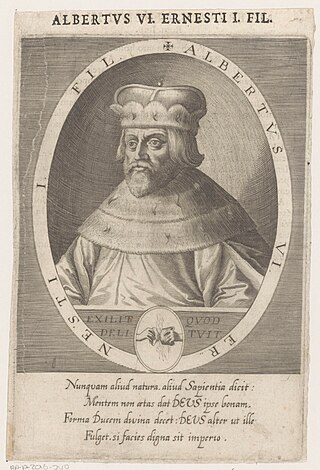
Albert III the Pious of Bavaria-Munich, since 1438 Duke of Bavaria-Munich. He was the son of Ernest, Duke of Bavaria and Elisabetta Visconti, daughter of Bernabò Visconti.
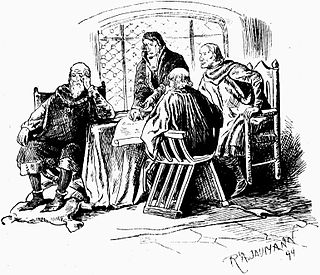
Ernest of Bavaria-Munich, , from 1397 Duke of Bavaria-Munich.

Louis VII, called the Bearded was the Duke of Bavaria-Ingolstadt from 1413 until 1443. He was a son of Duke Stephen III and Taddea Visconti.
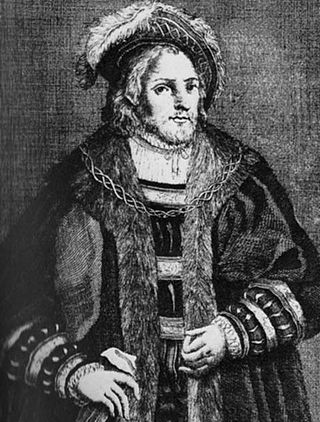
Henry XVI of Bavaria, , since 1393 Duke of Bavaria-Landshut. He was a son of duke Frederick and his wife Maddalena Visconti, a daughter of Bernabò Visconti.
The Parakeet Society was a union of the enemies of Louis VII the Bearded, duke of Bavaria-Ingolstadt. It was founded on April 17, 1414 by his cousin, duke Henry XVI of Bavaria-Landshut. The other members of the society were Ernest of Bavaria-Munich, his brother William III and John, Count Palatine of Neumarkt.
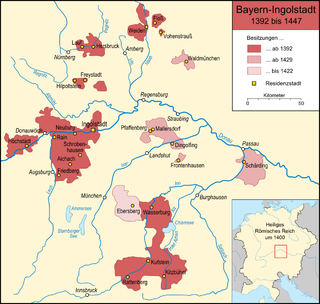
Bavaria-Ingolstadt was a sub-duchy which was part of the Holy Roman Empire from 1392 to 1447.

The Free Imperial City of Nuremberg was a free imperial city – independent city-state – within the Holy Roman Empire. After Nuremberg gained piecemeal independence from the Burgraviate of Nuremberg in the High Middle Ages and considerable territory from Bavaria in the Landshut War of Succession, it grew to become one of the largest and most important Imperial cities, the 'unofficial capital' of the Empire, particularly because numerous Imperial Diets and courts met at Nuremberg Castle between 1211 and 1543. Because of the many Diets of Nuremberg, Nuremberg became an important routine place of the administration of the Empire during this time. The Golden Bull of 1356, issued by Emperor Charles IV, named Nuremberg as the city where newly elected kings of Germany must hold their first Imperial Diet, making Nuremberg one of the three highest cities of the Empire.

Elisabeth of Bavaria-Landshut, nicknamed "Beautiful Beth", was an Electress of Brandenburg by marriage to Frederick I, Elector of Brandenburg. She acted as regent of Brandenburg during the absence of her spouse.
Margaret of Brandenburg was a Princess of Brandenburg by birth and through successive marriages Duchess of Mecklenburg, Duchess of Bavaria-Ingolstadt and Countess of Waldenfels.
Bavarian War may refer to:

Leienfels Castle was a late medieval aristocratic castle, immediately northwest of the eponymous village of Leienfels in the region of Franconian Switzerland in Germany. The village belongs to the borough of Pottenstein in the Upper Franconian county of Bayreuth in Bavaria.

Thuisbrunn Castle is located centrally within the parish of Thuisbrunn in the municipality of Gräfenberg in the Bavarian province of Upper Franconia. After having been destroyed and rebuilt several times, the castle is now in private ownership.
The Löwlerbund was a Adelsgesellschaft based in the Bavarian Forest and Lower Bavaria. It was formed in 1489 by Bavarian knights to oppose their lord, Duke Albert IV, who had claimed the right to levy taxes on them without their consent. The League moved into formal rebellion on 9 December 1491, under the leadership of Sigmund von Sattelbogen. It received support from Emperor Frederick III and the Swabian League, but was repeatedly defeated. In a peace agreement on 7 August 1493, Albert IV conceded the point on taxation and the League was disbanded.